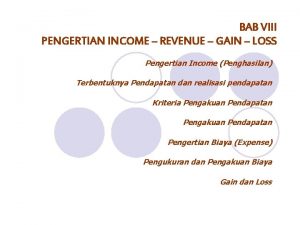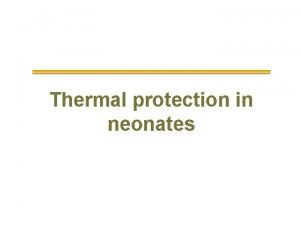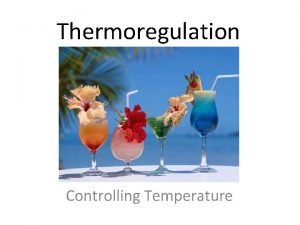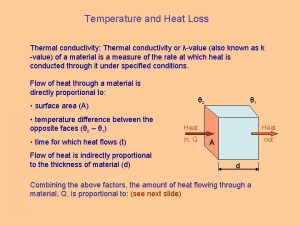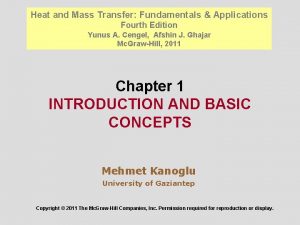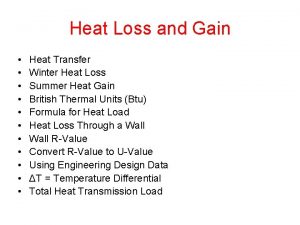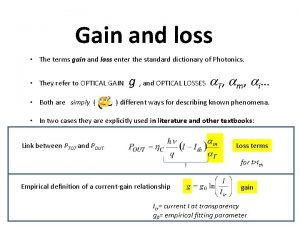RESIDENTIAL HVAC HEAT LOSS GAIN APPLICATIONS OF TECHNOLOGY


















- Slides: 18

RESIDENTIAL HVAC (HEAT LOSS & GAIN) APPLICATIONS OF TECHNOLOGY

WHAT IS HEAT TRANSFER? Heat transfer is the exchange of thermal energy from one physical body to another by dispelling heat. Heat is always transferred from a region of high temperature to a region of low temperature Thermal comfort is achieved when equilibrium exists between the human body and its environment.

HOW IS HEAT TRANSFERED? Heat may be transferred in the following ways: Conduction: transfer of heat through direct physical contact. What are some examples of conduction?

HOW IS HEAT TRANSFERED? Heat may be transferred in the following ways: Convection: transfer of heat through the circulation of a liquid or gas. What are some examples of convection?

HOW IS HEAT TRANSFERED? Heat may be transferred in the following ways: Radiation: transfer of heat through rays, waves, or particles. What are some examples of radiation?

HEAT LOSS/GAIN When do we typically experience heat loss? What is the temperature difference indoors vs outdoors? Heat loss normally occurs during the winter when the indoor tempature is higher than the outdoor temperature.

HEAT LOSS/GAIN When do we typically experience heat gain? What is the temperature difference indoors vs outdoors? Heat gain normally occurs during the summer when the indoor tempature is lower than the outdoor temperature.

WHAT ARE SOME CAUSES OF HEAT LOSS/GAIN? • openings (windows, doors, other places where air may leak into the building) • lighting • equipment • people

THERMAL UNITS • Btu (British Thermal Unit) – the amount of heat need to raise the temperature of 1 pound water by 1 degree • 1 watt = 3. 4 btu/hr • 1 ton = 12, 000 btu/hr (used in air conditioning)

R-VALUE VS U-FACTOR R-value (thermal resistance): the ability of a material to resist heat traveling through it. How effective is this material in terms of insulation? U-factor (heat conductivity): measurement of the rate of transfer of heat. How well does heat travel through this material? WHAT’S RELATIONSHIP BETWEEN RVALUE AND U-FACTOR?

FORMULA FOR HEAT LOAD Q' = AU T Where Q' = Total cooling/heating load in A = Area under investigation in ft 2 U = Coefficient of heat conductivity in T = Difference in temperature between outside and inside conditions in °F

HEAT LOSS THROUGH A WALL: AREA Height = 8 ft Length = 21 ft Area = 8 ft x 22 ft = 176 ft² Subtract area of any openings 2 Windows (3 ft wide x 4 ft tall) 2(12 ft 2)=24 ft² Wall Area 176 ft² -24 ft² =152 ft²

HEAT LOSS THROUGH A WALL: RVALUE Each material in the construction of wall has its own R-Value. Some R-Values are based on the thickness of the material.

HEAT LOSS THROUGH A WALL: RVALUE Outside Air Film neglect Siding 1. 05 Vapor Barrier 0. 06 Plywood 0. 62 Insulation 13. 00 Drywall 0. 45 Inside Air Film 0. 68 Total R-Value 15. 86

HEAT LOSS THROUGH A WALL: UVALUE Total R-Value= 15. 86 0. 06305 U =. 063 (Do not round up) Cut-off at three decimal places

USING ENGINEERING DESIGN DATA T = TEMPERATURE DIFFERENTIAL For heating calculations, we use a temperature that has been exceeded 97. 5% of the year. Source: 2012 International Plumbing Code, Table D 101 For cooling calculations we use a temperature value has been exceeded only 2. 5% of the year.

T = TEMPERATURE DIFFERENTIAL The difference between the design outside temperature and the design inside temperature Design Outside Temperature 13 °F (in Baltimore, MD) Design Inside Temperature 68 °F Inside Design Temperatures typically range from 67 °F to 82 °F

TOTAL HEAT LOSS (OR TRANSMISSION LOAD) Q' = AU T A = (8 ft) (21 ft) = 186 ft 2 – 24 ft 2 (WINDOWS)= 152 ft 2 U =. 063 T = 68°F - 13°F = 55 °F
 Siemens hvac control system
Siemens hvac control system Gain/loss
Gain/loss Optical loss and gain in semiconductors
Optical loss and gain in semiconductors The method of unit costing is adopted by
The method of unit costing is adopted by Heat gain makes the ice to
Heat gain makes the ice to Evaporative heat loss newborn
Evaporative heat loss newborn Heat loss form factor
Heat loss form factor Sri damayanti
Sri damayanti Convection in newborn
Convection in newborn Heat loss calculator excel
Heat loss calculator excel Heat loss rate
Heat loss rate Factors affecting heat loss
Factors affecting heat loss Vasoconstriction heat loss
Vasoconstriction heat loss Thermal conduction resistance
Thermal conduction resistance Heat transfer
Heat transfer Chapter 23.1 performing range of motion exercises
Chapter 23.1 performing range of motion exercises Types of heat pipes
Types of heat pipes Skinput
Skinput Pharmaceutical biotechnology notes
Pharmaceutical biotechnology notes

